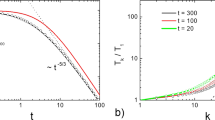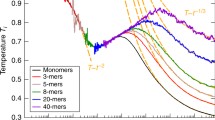Abstract
Heat transfer through a granular system with a random structure in the state of free filling is discussed. A model of random structure is proposed and a method for calculating the effective thermal conductivity of a granular system is presented.
Similar content being viewed by others
Literature cited
G. N. Dul'nev, Yu. P. Zarichnyak, and B. L. Muratova, Inzh.-Fiz. Zh.,16, No. 6 (1969).
Yu. P. Zarichnyak, Thermal Conductivity of Granular and Loosely-Bound Materials, Authors Abstract of Candidate's Dissertation [in Russian] LITMO, Leningrad (1970).
D. Kunii and J. M. Smith, A. I. Ch. E. Journal,6, No. 1 (1960).
M. G. Kaganer, “Thermal Insulation in Low-Temperature Technology [in Russian], Mashinostroenie (1966).
M. A. Eremeev, “On the average number of contacts in granular systems,” in: Energy and Material Transfer Processes at Low Temperatures in Vacuo [inRussian], Minsk (1973).
V. S. Nikitin, Investigation of the Effective Electrical Conductivity of Fillings of a Dispersed Material at Low Temperatures, Author's Abstract of Candidate's Dissertation [in Russian], ITMO AN BSSR, Minsk (1969).
I. N. Bronshtein and K. A. Semendyaev, Mathematics Handbook [in Russian], Moscow (1957).
Author information
Authors and Affiliations
Additional information
Translated from Inzhenerno-Fizicheskii Zhurnal, Vol. 26, No. 5, pp. 870–878, May, 1974.
Rights and permissions
About this article
Cite this article
Dul'nev, G.N., Eremeev, M.A. & Zarichnyak, Y.P. Heat transfer in granular systems with a random structure. Journal of Engineering Physics 26, 606–612 (1974). https://doi.org/10.1007/BF00826003
Received:
Issue Date:
DOI: https://doi.org/10.1007/BF00826003




